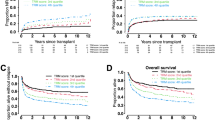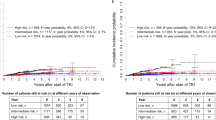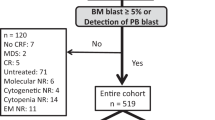Abstract
Several scoring systems have been developed to assess suitability of individual patients for intensive acute myeloid leukemia (AML) therapy. We sought to compare the performance of these scores in a cohort of 428 consecutive adults with AML who received conventional induction chemotherapy in five academic centers in France. All scoring systems identified a subset of patients with increased 28 and 56-day mortality although the prediction accuracy was overall limited with C-statistics of ranging from 0.61 to 0.71 Overall survival (OS) prediction was more limited and restricted to scoring systems that include AML-related parameters. The outcome of 104 patients (24%) considered unsuitable for intensive chemotherapy based on criteria used in recent randomized trials was similar to that of the other 324 patients (28-day mortality, odds ratio [OR] = 1.88, P = 0.2; 56-day mortality, OR = 1.71, P = 0.21; event-free survival, hazard ratio [HR] = 1.08, P = 0.6; OS, HR = 1.25, P = 0.14) with low discrimination (C-statistic: 0.57, 0.56, 0.50, and 0.52 for 28-day, 56-day mortality, EFS, and OS, respectively). Together, our findings indicate that the accuracy of currently available approaches to identify patients at increased risk of early mortality and shortened survival after intensive AML therapy is relatively limited. Caution regarding the use of available scoring systems should be warranted in clinical decision-making.
This is a preview of subscription content, access via your institution
Access options
Subscribe to this journal
Receive 12 print issues and online access
$259.00 per year
only $21.58 per issue
Buy this article
- Purchase on Springer Link
- Instant access to full article PDF
Prices may be subject to local taxes which are calculated during checkout



Similar content being viewed by others
References
Sánchez‐Vizcaíno F, Tamayo C, Ramos F, Láinez‐González D, Serrano‐López J, Barba R et al. Identification of seasonal variation in the diagnosis of acute myeloid leukaemia: a population‐based study. Br J Haematol. 2022;198:545–55.
Juliusson G, Antunovic P, Derolf Å, Lehmann S, Möllgård L, Stockelberg D, et al. Age and acute myeloid leukemia: real world data on decision to treat and outcomes from the Swedish Acute Leukemia Registry. Blood. 2009;113:4179–87.
Appelbaum FR, Gundacker H, Head DR, Slovak ML, Willman CL, Godwin JE, et al. Age and acute myeloid leukemia. Blood. 2006;107:3481–5.
Etienne A, Esterni B, Charbonnier A, Mozziconacci M-J, Arnoulet C, Coso D, et al. Comorbidity is an independent predictor of complete remission in elderly patients receiving induction chemotherapy for acute myeloid leukemia. Cancer. 2007;109:1376–83.
Hjort Jakobsen L, Stidsholt Roug A, Kiesbye Øvlisen A, Werenberg Marcher C, Beier Ommen H, Theilgaard‐Mönch K, et al. Temporal changes in survival among adult patients with acute myeloid leukaemia in the period 2000–16: a Danish population‐based study. Br J Haematol. 2021;193:482–7.
Juliusson G, Hagberg O, Lazarevic VL, Ölander E, Antunovic P, Cammenga J, et al. Improved survival of men 50 to 75 years old with acute myeloid leukemia over a 20-year period. Blood. 2019;134:1558–61.
Kaplan ZLR, van Leeuwen N, Posthuma EFM, Visser O, Huls G, van de Loosdrecht AA, et al. Improved relative survival in older patients with acute myeloid leukemia over a 30-year period in the Netherlands: a long haul is needed to change nothing into something. Leukemia. 2022;36:596–8.
Dombret H, Seymour JF, Butrym A, Wierzbowska A, Selleslag D, Jang JH, et al. International phase 3 study of azacitidine vs conventional care regimens in older patients with newly diagnosed AML with >30% blasts. Blood. 2015;126:291–9.
Wei AH, Montesinos P, Ivanov V, DiNardo CD, Novak J, Laribi K, et al. Venetoclax plus LDAC for newly diagnosed AML ineligible for intensive chemotherapy: a phase 3 randomized placebo-controlled trial. Blood. 2020;135:2137–45.
DiNardo CD, Jonas BA, Pullarkat V, Thirman MJ, Garcia JS, Wei AH, et al. Azacitidine and venetoclax in previously untreated acute myeloid leukemia. N Engl J Med. 2020;383:617–29.
Sorror ML, Storer BE, Fathi AT, Brunner A, Gerds AT, Sekeres MA, et al. Multisite 11-year experience of less-intensive vs intensive therapies in acute myeloid leukemia. Blood. 2021;138:387–400.
Palmieri R, Othus M, Halpern AB, Percival M-EM, Godwin CD, Becker PS, et al. Accuracy of SIE/SIES/GITMO consensus criteria for unfitness to predict early mortality after intensive chemotherapy in adults with AML or other high-grade myeloid neoplasm. JCO. 2020;38:4163–74.
Walter RB, Othus M, Borthakur G, Ravandi F, Cortes JE, Pierce SA, et al. Prediction of early death after induction therapy for newly diagnosed acute myeloid leukemia with pretreatment risk scores: a novel paradigm for treatment assignment. JCO. 2011;29:4417–24.
Sorror ML, Storer BE, Fathi AT, Gerds AT, Medeiros BC, Shami P, et al. Development and validation of a novel acute myeloid leukemia–composite model to estimate risks of mortality. JAMA Oncol. 2017;3:1675.
Ferrara F, Barosi G, Venditti A, Angelucci E, Gobbi M, Pane F, et al. Consensus-based definition of unfitness to intensive and non-intensive chemotherapy in acute myeloid leukemia: a project of SIE, SIES and GITMO group on a new tool for therapy decision making. Leukemia. 2013;27:997–9.
Sasaki K, Kadia T, Begna K, DiNardo CD, Borthakur G, Short NJ, et al. Prediction of early (4-week) mortality in acute myeloid leukemia with intensive chemotherapy. Am J Hematol. 2022;97:68–78.
Pigneux A, Béné MC, Salmi L-R, Dumas P-Y, Delaunay J, Bonmati C, et al. Improved survival by adding lomustine to conventional chemotherapy for elderly patients with AML without unfavorable cytogenetics: results of the LAM-SA 2007 FILO. Trial JCO. 2018;36:3203–10.
Lancet JE, Uy GL, Newell LF, Lin TL, Ritchie EK, Stuart RK, et al. CPX-351 versus 7+3 cytarabine and daunorubicin chemotherapy in older adults with newly diagnosed high-risk or secondary acute myeloid leukaemia: 5-year results of a randomised, open-label, multicentre, phase 3 trial. Lancet Haematol. 2021;8:e481–e491.
Grimwade D, Hills RK, Moorman AV, Walker H, Chatters S, Goldstone AH, et al. Refinement of cytogenetic classification in acute myeloid leukemia: determination of prognostic significance of rare recurring chromosomal abnormalities among 5876 younger adult patients treated in the United Kingdom Medical Research Council trials. Blood. 2010;116:354–65.
Döhner H, Estey E, Grimwade D, Amadori S, Appelbaum FR, Büchner T, et al. Diagnosis and management of AML in adults: 2017 ELN recommendations from an international expert panel. Blood. 2017;129:424–47.
Sorror ML, Maris MB, Storb R, Baron F, Sandmaier BM, Maloney DG, et al. Hematopoietic cell transplantation (HCT)-specific comorbidity index: a new tool for risk assessment before allogeneic HCT. Blood. 2005;106:2912–9.
Moons KGM, Altman DG, Reitsma JB, Ioannidis JPA, Macaskill P, Steyerberg EW, et al. Transparent Reporting of a multivariable prediction model for Individual Prognosis Or Diagnosis (TRIPOD): Explanation and Elaboration. Ann Intern Med. 2015;162:W1–73.
Duchmann M, Micol J-B, Duployez N, Raffoux E, Thomas X, Marolleau J-P, et al. Prognostic significance of concurrent gene mutations in intensively treated patients with IDH -mutated AML: an ALFA study. Blood. 2021;137:2827–37.
Fenwarth L, Thomas X, de Botton S, Duployez N, Bourhis J-H, Lesieur A, et al. A personalized approach to guide allogeneic stem cell transplantation in younger adults with acute myeloid leukemia. Blood. 2021;137:524–32.
Orvain C, Othus M, Johal G, Hunault-Berger M, Appelbaum FR, Walter RB. Evolution of eligibility criteria for non-transplant randomized controlled trials in adults with acute myeloid leukemia. Leukemia. 2022:36;2002–8.
Acknowledgements
We would like to acknowledge all the medical teams and pharmacists from each participating center for their help on identifying patients and collecting data.
Author information
Authors and Affiliations
Contributions
Conception and Design: CD, CO. Collection and Assembly of Data: CD, PP, TM, MAC, AV, JBM, PC, GG, EG. Data Analysis and Interpretation: CD, JR, ATS, RBW, MHB, CO. Manuscript Writing: All authors. Final Approval of the Manuscript: All authors.
Corresponding author
Ethics declarations
Competing interests
Employment or Leadership Position: none; Consultant or Advisory Role: MHB, Erytech©; Stock Ownership: none; MHB, Abbvie, Incyte, and Jazz Pharmaceuticals, CO, Novartis; Research Funding: none; Expert Testimony: none; Patents: none; Other Remuneration: none.
Additional information
Publisher’s note Springer Nature remains neutral with regard to jurisdictional claims in published maps and institutional affiliations.
Supplementary information
Rights and permissions
Springer Nature or its licensor holds exclusive rights to this article under a publishing agreement with the author(s) or other rightsholder(s); author self-archiving of the accepted manuscript version of this article is solely governed by the terms of such publishing agreement and applicable law.
About this article
Cite this article
Desprez, C., Riou, J., Peterlin, P. et al. Comparison of scoring systems evaluating suitability for intensive chemotherapy in adults with acute myeloid leukemia—a Grand Ouest Against Leukemia (GOAL) study. Leukemia 36, 2408–2417 (2022). https://doi.org/10.1038/s41375-022-01677-z
Received:
Revised:
Accepted:
Published:
Issue Date:
DOI: https://doi.org/10.1038/s41375-022-01677-z



